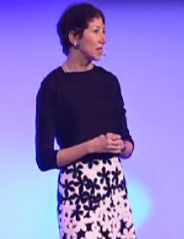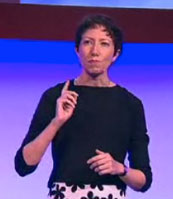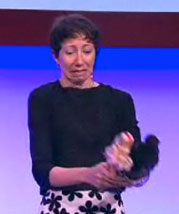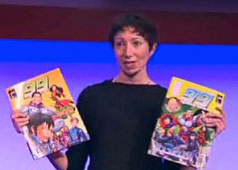Analyzing Language and Delivery
El Feki’s presentation is concise, and she presents a simple message: Arab pop culture borrows from the West but retains its own identity (much like American culture borrows from immigrant cultures). Her examples seem to support her position.
Once you have a good feel for the message and support, you can begin analyzing the presentation’s delivery. Let’s look at El Feki’s language and voice.
As you listen, pay close attention to the following:
- The formality of Dr. El Feki’s language
- How she uses language to connect with her audience
- What impression she gives through her choice of words
- The pace or speed of her presentation
- Her tone or attitude
Source: “Pop Culture in the Arab World,” Shereen El Feki, TED Talks
Using your notes, answer these questions. Check your understanding after each response.
- How formal is Dr. El Feki’s language?
- Does the formality change during the presentation? When? How?
- How does she use language to connect with her audience?
- What impression does her choice of words give the audience?
- What is Dr. El Feki’s tone, or attitude, toward her subject?
- How does her pace support her presentation?
Sample Responses:
Fairly informal, to match her subject matter
CloseSample Responses:
It gets a little more formal as she analyzes the significance of the mesh of cultures.
CloseSample Responses:
Her informality makes her seem friendly and approachable. She uses humor and children’s dolls to break the ice.
CloseSample Responses:
Initially the informal language seems a bit too informal, and her doll seems childish. However, as she discusses the significance of the pop culture, her “simple” message takes on added layers of complexity.
CloseSample Responses:
She seems interested in the topic. She likes how the cultures mesh. However, she doesn’t seem extremely enthusiastic.
CloseSample Responses:
She speaks slowly and very clearly. She pauses often. She varies her language so that she appears friendly, yet knowledgeable. She speaks slowly and clearly so that everyone can understand her, and she seems interested in her topic.
CloseNow let’s look at her body language, eye contact, and visuals.
Watch the video again, looking at Dr. El Feki’s posture, eye contact, gestures, and props, and other visuals.
Source: “Pop Culture in the Arab World,” Shereen El Feki, TED Talks
Think about each of these questions. When you have a response in mind, click the link to check your understanding.
- What does Dr. El Feki’s posture suggest to her audience?
- How does her eye contact help her connect with her audience?
- How do her gestures support her ideas?
- How do her facial expressions help support her positions?
- How do her props and visuals support her position?

Source: “Pop Culture in the Arab World,” Shereen El Feki, TED Talks
Sample Responses:
She is confident.
CloseSample Responses:
Her eye contact with the audience makes her seem friendlier and makes her speech seem more informal. Her eye contact also helps to hold the audience’s attention.
Close
Source: “Pop Culture in the Arab World,” Shereen El Feki, TED Talks
Sample Responses:
They help her point out important ideas.
Close
Source: “Pop Culture in the Arab World,” Shereen El Feki, TED Talks
Sample Responses:
She demonstrates the clash of cultures she mentions later in the presentation.
Close
Source: “Pop Culture in the Arab World,” Shereen El Feki, TED Talks
Sample Responses:
They are strong evidence of her points. Her visuals and props show clear examples of similarities and differences in pop cultures.
Close